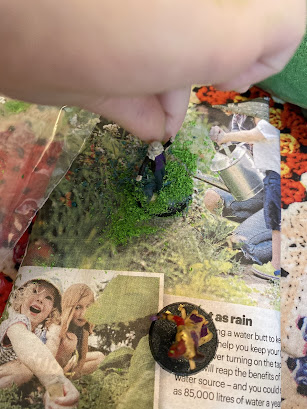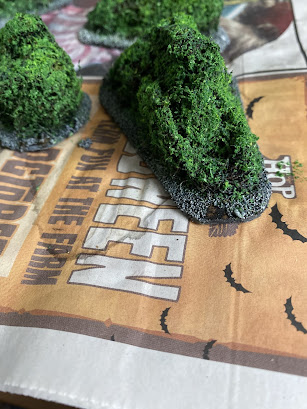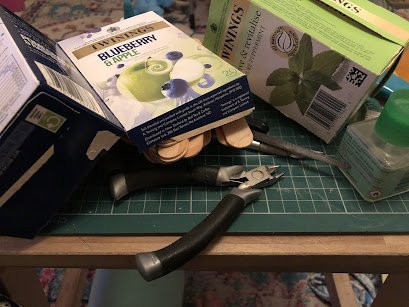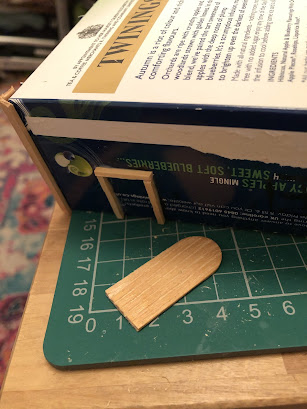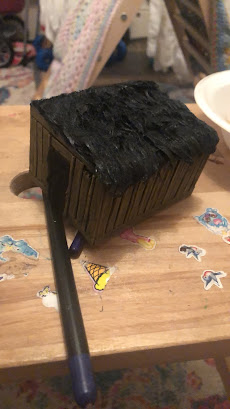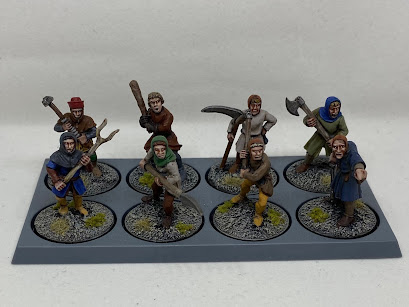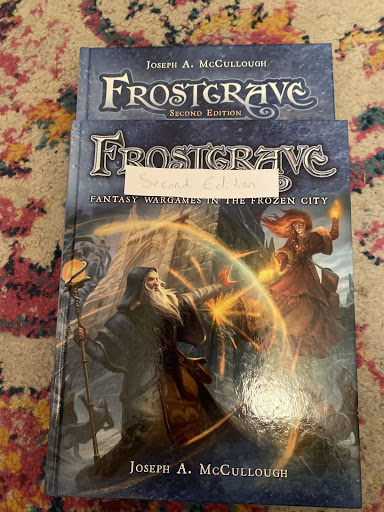Apologies to everyone that follows me on Instagram for pulling this prank when I first got my copy of Second Edition:
So, apologies aside, welcome to what is presumably the international premier review of the new edition of Osprey Games’ Frostgrave!
Before we get into the book proper, a brief discussion of my history with Frostgrave – I first played a demo game at Salute, either shortly before or just after it had originally been released. Each player had a Wizard and a couple of soldiers, and I plumped for the Necromancer, mostly for the opportunity to field battle eyeliner. In the demo game, we scrambled through snowy ruins trying to gain control of some plastic coins, my wizard shooting bone darts at anyone he could, culminating in fisticuffs atop some steps where after losing a couple of the lads I rolled a 20, and my Soldier did a ridiculous amount of damage to his opponent, lopping off his head and starting discussions as to whether this particular hero was in fact the leader of the warband as opposed to the decidedly less deadly chap in the robe, and leading to me winning the game and walking away with a pair of chocolate coins and a newfound love for the game.

(Apparently I only have the worlds blurriest picture from so far back in the past)
Some people don’t like the d20, and why they are wrong
One criticism that you might hear about Frostgrave is that using a 20 sided die makes it ‘too swingy’. Now, I could go off on a long tangent here about most war gamers having designed rules at some point and debated the benefits of different dice (or even calculated the probabilities of different results in order to model where a shot would land on a giant robot, for a completely out of thin air example), but that’s not what you’re here to read, so I’ll attempt a short version! Warhammer uses a D6, which is fine, people are used to them, but it doesn’t actually give you a lot of potential results, resulting in situations where your godlike superhuman and a well trained but actually comparatively squishy human statistically have the same chance of achieving the same result, whereas polyhedral dice can give a wider spread of results. Scale I suppose is another factor; in a mass battle game you might be rolling a bucketful of dice as your anthropoid fungus wildly fire their automatic weaponry, so it’s better to have less potential results to have to mentally compute, whereas in a small scale skirmish you’re probably rolling a single die. Everything else aside, the d20 has a long association with Dungeons and Dragons (and other role playing games), so if nothing else is semiologically associated with fantasy! Plus, rolling a 20 is just so much more satisfying than rolling a 6 (as everyone knows that despite what mathematics might suggest superstitious gamers know that there’s always less than 5% chance of rolling a crit, but more than 5% of rolling a 1…)
So, Frostgrave hit the scene running and was immensely popular, with good reason. It’s a fun game, well supported, and is miniature agnostic so grumpy old gamers with existing collections of miniatures could just start playing without having to buy a whole new set of miniatures. I’d argue that this last point is the elephant in the room though, the greatest lie ever told, as if the game is miniatures neutral why do they produce such a beautiful set of miniatures for it? Honestly, look at these:
Tell me you’re not tempted to find out more about this game by those alone.
And there are more coming out with the release of this new edition too...
(If Nick Eyre is reading this, I’ll happily shill any miniatures that you want to send me, there isn’t a single bad one that I’ve seen)
So, here's what you’re actually here for, rather than my musings on dice size and salivating over North Star Miniature Figures ranges, the review itself:
Although Frostgrave was wildly successful on release, it was Joseph McCullough’s first published war game, and he himself describes it as containing various errors and inconsistencies. However, in the five years since he’s been incredibly busy, writing various supplements, campaigns, and even whole other war games, and so between that and five years of player feedback, we find ourselves in a position where it makes sense to update the rules in a new edition (you will see some of the lessons learned from developing things like Rangers of Shadow Deep when you get your hands on the new book). Page 12 of the new book has a note from the author where he talks about this and discusses his design goals for the new edition; I won’t repeat it all here, but I will list those goals:
1. Make the game more fun, not less.
2. Make the rules clearer, more balanced, and more streamlined, but not at the cost of #1.
3. Keep all the supplements to the first edition useable and relevant.
While the game is different enough to warrant a whole new book rather than issuing an errata pdf, it’s worth noting that it’s very much still the same game, and that frankly you will recognise more than you won’t: the majority of changes seem to be tweaks and rebalancing, as you’ll see later in the review…
One thing you’ll notice when you get your hands on it, the new book is noticeably thicker than the old one though!
Before I go chapter by chapter, I want to talk about the art and flavour text throughout the book. Frostgrave has always had beautiful art; the high production value of the original rule book is surely one of the reasons that the game was so popular: once you started flicking through, you were guaranteed to have something catch your eye and get you digging further! This Second Edition though takes that approach and turns it up to 11, the quantity and quality of the art throughout is just great. The flavour text boxes are back, some recycled from the original book but along with some new additions, like “It was kind of funny at first – if you stood in the green mist, all anyone could see of you was your skeleton. Then the real skeletons showed up and things got confusing…” which made me laugh, then made me start thinking of scenarios…
Chapter one wizards and warbands
This is still Frostgrave, so you still get to raise a posse of toughs and thugs to accompany your wizard into the frozen city, although there have been a couple of tweaks, including things like Apprentices starting with 12 rather than 10 health, and the introduction of the Specialist Soldier table. Wizards are now limited to a maximum of four Specialists in their warband, which puts paid to groups consisting solely of crossbowmen punishing anyone that dares to venture out of cover to try and grab treasure! The majority of soldiers have had their prices change, too, including Thugs and Thieves now being free, which I think is a fantastic decision, as it means that even if the dice turn against you in a campaign and you find yourself with no gold in the bank and a roster full of dead soldiers, you can make up your numbers with low skill mooks and not be hamstrung by being woefully outnumbered…
Other changes come in the weapons section, and bring a lot of things more in line with what we’re used to with Rangers of Shadow Deep, like two-handed weapons taking up two item slots, needing to carry a quiver to be able to use a bow or crossbow, and the removal of the original rule that gave figures wielding both a dagger and a hand weapon +1 Fight, which is something the author had been unhappy about since at least 2016, and I think is the right choice to make (although I’m sure someone will argue that it makes perfect sense for someone carrying a knife in their boot to be harder to shoot). There are also separate rules for shields and armour (like heavy armour giving +2 Armour and -1 Move), that I could have sworn were in first edition, but checking my actual book apparently were not, they were just baked into the soldiers profiles, and called leather and mail armour rather than light and heavy! There’s also a new rule that caps maximum Armour Stat at 15 for permanent warband members, to prevent cunning combinations of items, magic and special effects creating the nigh-invincible Knight that’s just no fun for anyone to play against!
Chapter Two: Playing the game
The game runs much the same (as it’s always been fairly solid) with a few tweaks, such as in a ‘standard’ game now rather than each player placing 3 tokens, 5 are placed, with one being the ‘central’ treasure, two placed within 8” of it, and the last two anywhere else (with a few limitations), which should ensure a good spread and lead to an action packed game!
Now, I’m not going to go through everything in this chapter – (
pre-order the book from Northstar – if Nick from Northstar is reading this, I’ll happily take my commission in metal and plastic) but rest assured, the phases are still the same, you still get to batter your opponents with miniatures, there’s just a lot more… clarity, in this new edition. For fear of overusing a phrase, you can see where five years of feedback and a community of players stress testing the system have really come in handy to make this the best book it can be. Some of it is just making it easier to learn the game, like having the rules for making stat rolls in this chapter when it wasn’t in the original edition, or including a Combat Summary after that particular rules section, whereas the original edition was happy to jump straight to the rules for shooting! Other things that were added to the system after the original books release have been added too, like the swimming rules from Ghost Archipelago (which I don’t have, so can’t pass comment on whether they’ve changed - they’re functionally the same as the swimming rules from Rangers of a Shadow Deep though, barring it being a Will roll rather than testing against Swimming skill)
Side note: unmodified 20s being an automatic success and unmodified 1s being an automatic failure is another thing that I could have sworn was in the original edition, but I can now find no trace of – it should be, as it’s one of those things that makes for a good story for gamers, and making for exciting gameplay moments like that is the reason that most people house rule it into Dungeons and Dragons…
One final thing on this chapter, and again I’m going to praise the aim of clarity, highlighted in the presentation of the rules for controlling creatures; compare this:
(From first edition)
To this:
(From second)
It’s only a little thing, but the latter is much easier to reference, and I think more in line with the presentation of similar rules in Rangers of Shadow Deep, and should make for a smoother experience at the table!
Chapter Three: The Campaign
While it’s possible to play a one off game of Frostgrave, the real meat of the experience is in campaign play, and I think a large part of why it captured so many our our imaginations when it was first released was that a lot of us had a Mordheim shaped hole in our hearts!
The campaign rules still have everything you’d expect, from rules for Wizards losing fingers to an experience system to allow your wizard to learn and grow over the span of several games (although the experience chart has changed somewhat since first edition – gone is the 150 point gain for personally killing an enemy wizard, which should mean that someone playing an offensive wizard doesn’t end up shooting up the levels, making him better at killing enemy wizards, and thus earning even more experience, leading to a disparity between players that might make for a less than fun playing experience). Similarly, the treasure table has had potential results flattened slightly, such as result 20 being 120gc and a Grimoire rather than the originals 200, which presumably will also reduce situations with one wizard getting too far ahead of his peers (whilst still retaining enough randomness to be exciting and fun). The potion rules are much expanded from the first edition, and the magic weapon and armour table, whilst similar, has also received a few tweaks (hello hand weapon giving +2 Will!). A lot of prices have also been tweaked, with a number of items becoming more expensive, which looks to be another effort to bring greater balance to the game. Also gone are some items like the Drinking Horn of Healing and the Banner of Courage, replaced by things like the Construct Hammer, a magic hammer you can bolt on to one of your constructs!
Rules for establishing a base are still in second edition, you will be pleased to hear, although as with everything else I’ve mentioned there have been some tweaks! It’s such a flavourful addition to the game, but with a mechanical benefit that makes it worth using! My only criticism of the book so far comes in this section, as the Treasury base has players rolling a d20 to see what they find, but gives no result for what happens if you roll a 1, whereas in first edition rolling a 1 meant the warband set off a magic trap, and a soldier had to miss the next game as a result. Intentional omission or editing error? I’m leaning toward the former, with a roll of 1 being ‘you find nothing’ as being a soldier down can put you at something of a disadvantage in your next game (especially if you have other soldiers missing the game due to injury) but it’s unusual for it not to be spelled out in a rule book that I’ve spent the last several paragraphs praising for its focus on clarity… [I messaged the author and he confirmed that it’s an intentional omission, as part of balancing the bases this was the only one that had a negative in it]
Chapter Four: Spells
A good chunk of the book is taken up with rules for the various spells, perhaps unsurprisingly given that it’s a game of wizards battling for dominance!
Again, I’m not going to list the spells or go through them one by one (
buy the book!), but I will say a lot of things have been tweaked! One of Joseph McCullough’s stated aims with this second edition was to revise and tighten the spell list, to try and make all of the spells equally attractive with the benefit of five years of hindsight and player feedback!
I’m especially excited by new spell ‘Animate Skull’, not for any particular gameplay or strategic reason, but because I already have a miniature that I can use for that:
Bone Dart, my favourite spell from the first game of Frostgrave I ever played, alas, has become harder to cast and had a 12” maximum range imposed on it, which admittedly is generally as far as you get to cast it anyway given how busy with terrain the table should be, but still, the dream was always to snipe someone from across the board… the spells are also alphabetised this edition, whereas in First they… sort of were, but there were some oddities like Brew Potion coming before Bone Dart and Bones of the Earth…
Grenade, on the other hand, has an increased range this edition, whilst maintaining the same difficulty to cast, so maybe there’s an Enchanter in my future…
While I said I wouldn’t go through the list spell by spell, I will give you with a list of the spells from First edition that are no longer in the game (although admittedly some have had their effects combined into other spells), and tease you with the names of the new spells that replace them, leaving it to your imagination as to what they actually do…
Gone: Monstrous Form, Reveal Death, Create Grimoire, Forget Spell, Reveal Invisible, Will Power, Restore Life
New: Blink, Animate Skull, Bridge, Mind Lock, Suggestion, True Sight, Destroy Undead
(Also Bind Demon is now Control Demon, but otherwise works the same)
Chapter Five: Scenarios
The ten original scenarios from First Edition remain (albeit slightly tweaked, but not so much that you wouldn’t recognise them), but are joined by ten new scenarios, totalling twenty complete scenarios to play – if we ever see a Third Edition, we’re going to need some bigger dice to use when picking a scenario! I’m a fan of scenarios with narrative elements, so am looking forward to scenarios like The Ice Storm, where warbands must pick the lock on a central treasure that is chained in place whilst dodging falling icicles (and admittedly I’m already considering how I’d adapt it to play as a Rangers of Shadow Deep scenario too, and maybe even The Lock Box as well…)
Another thing that I also like is that each scenario has a ‘Requirements’ section in their set-up instructions, much like you’ll see in a Rangers of Shadow Deep scenario, although as well as any specific creatures you might need it also includes any specific terrain, handy to know what you need to start building! There are also optional rules for balancing scenarios between wizards of vastly differing levels, handy if one player is starting to dominate the campaign!
Chapter Six: Bestiary
All the classics are here, with the addition of Animated Skulls and Skeleton Archers, although as with everything else things have been revised, with several creatures getting new stats: it’s going to be more dangerous for soldiers traipsing through the ruins in this edition! The book also features a list of Creature Traits, essentially keyworded abilities that appear on creatures rather than having them separately explained on each individual creature.
The book then ends with appendix of summaries of the original supplements, and what (if any) notable changes there are with the release of the second edition. I appreciate the intention to ensure that old supplements aren’t rendered unusable by the new edition, and think it’s great for old and new players alike, as there are several campaigns ready to play from the word go! I’d originally planned to adapt some of the Perilous Dark scenarios for use with Rangers of Shadow Deep, but I think I’m going to give them a run through as intended with a wizard as well until social distancing is relaxed enough that I can play games with other people again…
Then rounding out the book is pages of photocopiable spell cards, Wizard sheets, and 5 pages of quick reference rules to help you get through your first few games!
So, overall, I really like this. Did we need a new edition? It’s an interesting question. If this edition never came out, people would have kept on happily playing Frostgrave, I’m sure, but with the adjustments and tweaks made throughout the system, I think it’s time to herald in a new age of Frostgrave (and I’d be remiss if I didn’t at least
nod towards the new scenery sets coming out that are going to make it easier for anyone new to the game or even wargaming in general to get playing even quicker). Right, lets paint up a Necromancer...










